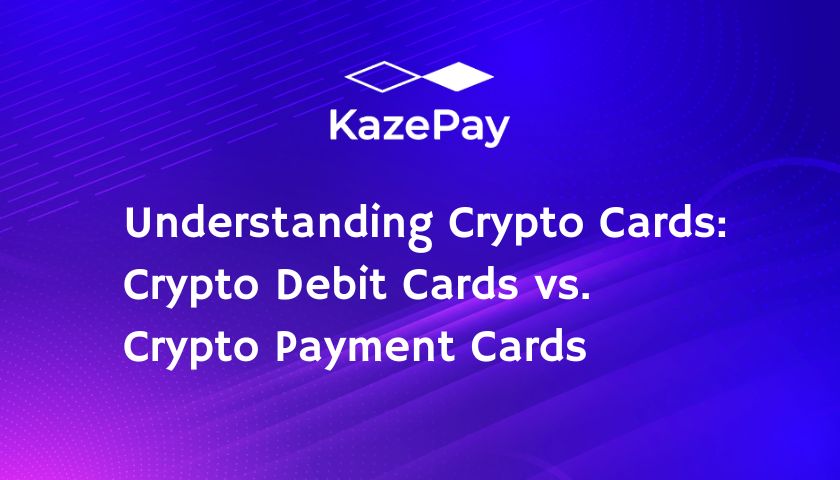Understanding Crypto Cards: Crypto Debit Cards vs. Crypto Payment Cards

The rise of cryptocurrencies has introduced new ways of handling money, and one of the most popular innovations is the crypto card. These cards make it easier for users to spend their cryptocurrencies in the real world, bridging the gap between digital assets and traditional finance. However, terms like “crypto debit card” and “crypto payment card” can often be confusing. In this blog, we’ll explore what crypto cards are, how they work, and the key differences between crypto debit cards and crypto payment cards.
What is a Crypto Card?
A crypto card is a payment card that allows users to spend cryptocurrencies in everyday transactions, just like a traditional credit or debit card. Instead of relying solely on fiat currencies like USD, EUR, or GBP, these cards tap into your crypto wallet to process payments.
Crypto cards typically work through partnerships between cryptocurrency platforms (like exchanges) and payment networks (such as Visa or Mastercard). They allow you to use cryptocurrencies to pay for goods and services at any merchant that accepts traditional card payments.
Types of Crypto Cards
1. Crypto Debit Card
A crypto debit card works similarly to a regular debit card but is linked to your cryptocurrency wallet instead of a bank account. Here’s how it operates:
- Preloaded Balance: You load your crypto debit card with cryptocurrency, which is held in your linked wallet or account.
- Real-Time Conversion: When you make a purchase, the card provider automatically converts the required amount of cryptocurrency into fiat currency at the current exchange rate.
- Spending Limit: Your spending limit depends on the amount of cryptocurrency you’ve loaded onto the card.
Key Features of Crypto Debit Cards:
- Instant conversion of crypto to fiat during transactions.
- Allows ATM withdrawals in fiat currency.
- Requires preloading cryptocurrency before usage.
2. Crypto Payment Card
A crypto payment card, on the other hand, allows users to directly pay with cryptocurrencies without necessarily preloading the card or converting funds in advance. It works more like a bridge between your crypto wallet and traditional payment systems.
- Direct Payments: The payment is made directly from your cryptocurrency wallet at the time of the transaction.
- Advanced Wallet Integration: These cards are often integrated with non-custodial wallets, where you control your private keys.
- No Preloading Required: Unlike crypto debit cards, there’s no need to preload funds—transactions happen directly from your wallet.
Key Features of Crypto Payment Cards:
- Direct spending from your crypto wallet.
- May involve higher transaction fees for real-time crypto payments.
- Often used for merchants that accept cryptocurrency as payment.
Key Differences Between Crypto Debit Cards and Crypto Payment Cards
| Feature | Crypto Debit Card | Crypto Payment Card |
|---|---|---|
| Preloading Required | Yes, you must load funds in advance. | No, payments are made directly from the wallet. |
| Conversion Process | Converts crypto to fiat during transactions. | Directly uses crypto without prior conversion. |
| Integration with Wallets | Linked to custodial wallets (hosted by platforms). | Often integrated with non-custodial wallets. |
| Merchant Acceptance | Can be used anywhere Visa/Mastercard is accepted. | Limited to merchants accepting crypto payments or cards supporting crypto-to-fiat conversion. |
| ATM Withdrawals | Supported in fiat currency. | Rarely supported. |
Advantages of Using Crypto Cards
- Convenience: Spend cryptocurrency effortlessly at millions of merchants worldwide.
- Accessibility: No need to sell crypto separately; conversion happens seamlessly.
- Rewards: Many crypto cards offer cashback rewards in Bitcoin or other cryptocurrencies.
- Global Use: Ideal for international travel since many crypto cards support multiple currencies.
Challenges and Limitations
- Fees: Some cards charge high transaction fees or monthly maintenance fees.
- Volatility: Cryptocurrency prices can fluctuate significantly, impacting spending power.
- Limited Acceptance: While growing, not all merchants or ATMs support crypto payment cards.
Conclusion
Crypto cards are reshaping how we use digital assets in everyday life by offering seamless integration with traditional financial systems. Choosing between a crypto debit card and a crypto payment card depends on your specific needs. If you want simplicity and widespread acceptance, a crypto debit card may be ideal. However, if you prefer direct payments from your wallet and advanced control over your funds, a crypto payment card might be a better fit.
As the adoption of cryptocurrencies continues to grow, crypto cards will likely become even more versatile and accessible, making them a valuable tool for crypto enthusiasts worldwide.
Introducing Kazepay – Your Gateway to Seamless Crypto Spending
Looking for a reliable and innovative way to spend your cryptocurrencies? Kazepay offers cutting-edge solutions for crypto payments, enabling you to use your digital assets effortlessly in everyday transactions. Whether you’re looking for a feature-rich crypto debit card or a direct payment option, Kazepay ensures secure, fast, and user-friendly services designed for modern financial needs.
Experience the ultimate convenience in crypto spending with Kazepay today! Visit Kazepay to learn more and get started!